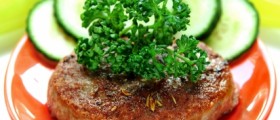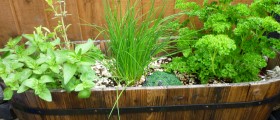
Proteins are very important for our body, as they determine the structure and function of all cells, and thus the tissues and organs. They are a necessary part of our diet. However, proteins cannot be absorbed into our body as such, because proteins in foods are too complex and too large to travel through the wall of our intestines. They need to be broken down by the process of digestion. Let us see how a complex molecule of protein is digested.
The mouth
Proteins are not digested in the mouth. What happens to almost all foods (save starch) in the mouth is just the chewing, which serves to turn the food into a well - ground pulp. Molecular structure of proteins remains unchanged in the mouth. Ground food is swallowed and ten it goes to the stomach.
The stomach
Stomach is basically an acid bath blender. It is a muscular sack whose inner lining secretes a powerful acid known as hydrochloric acid or stomach acid. pH of the secreted acid can be as low as 1. The food, soaked in this acid, stays in the stomach for a while. Contractions of the stomach (there are three contractions per minute on average) serve to mix its contents so that the entire quantity of food is evenly exposed to acid. Other types of stomach glands secrete enzymes, which serve to break up food ingredients chemically, and mucus, whose role is to protect the stomach itself from the hydrochloric acid by creating a protective layer over the stomach's walls lining. Despite this, the acid gets to the lining and destroys it, so it needs to be replaced all the time. It is thought that the entire stomach lining is replaced in just three days.
Enzymes that we mentioned are proteins whose role is to chop molecules in the food into simpler forms. A protein molecule can consist of many hundreds of amino acids. You can imagine a protein molecule as a string of amino acids similar to a pearl necklace, which has been bent and twisted and eventually combined with more strings to form an adequate shape, according to its purpose.
Enzymes in the stomach cut up this string into smaller pieces, more suited for the final stage of digestion. How fast the cutting (breaking) of the protein into smaller pieces (known as peptones and proteose) lasts depends on a number of factors, such as quantity of the enzymes, amount of protein in the food, temperature and acidity of the food, acidity of the stomach and presence of factors that inhibit digestion. In general, protein digestion in the stomach lasts for some four hours.
The small intestine
The food that was digested in the stomach, known as chyme, is moved into the small intestine by rhythmic contractions of the stomach that squeeze the chyme out. The first part of the small intestine is known as the duodenum. In it, the highly acidic chyme is neutralized (the acid is destroyed) by mixing with alkaline secretions.
Enzymes produced by the pancreas, trypsin and chymotrypsin break the proteins, peptones and proteose molecules into amino acids. Walls of the small intestine are covered with villi, microscopic finger-like protrusions, which increase the surface of the intestine walls. The walls of the villi are very thin and blood capillaries and lymph vessels are just beneath. Amino acids pass through the thin walls and through the capillary walls, and enter the bloodstream, which will carry them through the entire body, distributing them wherever they are needed for synthesis of proteins adequate to our organism's needs.
















Your thoughts on this
Loading...